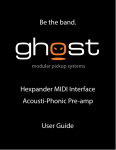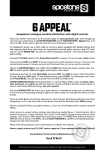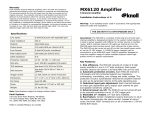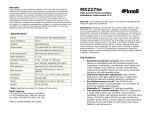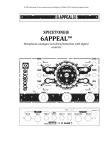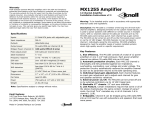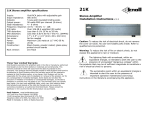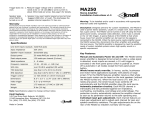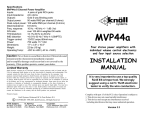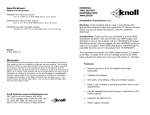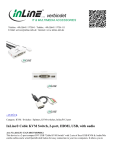Download ghost Hexpander Installation Guide
Transcript
Plug into a world of possibilities. GHOST Pickup System Hexpander Pre-amp User Guide Welcome to a World of Possibilities! Congratulations on your purchase of the GHOST™ Hexpander System! Using the highest quality components and state of the art design, the Ghost Hexpander System perfectly complements the latest midi, hexaphonic and/or virtual devices. Experience fast and accurate tracking that absolutely smokes... without volume dropouts or dead spots! The Ghost Hexpander System is your gateway to the infinite world of hexaphonic, virtual and midi possibilities. • The GHOST Modular Pickup System consists of custom engineered piezo pickups individually calibrated and supplied as a matched set. They are available in a variety of different saddle styles. Refer to the Graph Tech catalog for the correct saddle to suit your guitar before proceeding. • The Hexpander Pre-amp works in conjunction with the Ghost Pickups. It amplifies signals from up to six individual strings and sends them via a standard 13-pin connector to an external MIDI converter or sound processor. You get a world of synthesised MIDI instruments or a universe of analog sounds, all based on the crystal clear acoustic signal. The installation is completely independent of the original magnetic pickups of your instrument. • The Hexpander can be used alone or together with the Acousti-Phonic preamp; the two units just plug together. You get all the benefits of the AcoustiPhonic pre-amp - the fat equalised Ghost sound, blending with the original magnetic pickups, auto-switching stereo jack and optional switches and controls - and all the benefits of the Hexpander. Plus, the units work together to deliver blended sounds over the 13-pin interface, and more. This guide describes installing the GHOST Modular Pickups and the GHOST Hexpander Pre-amp in your guitar. 2 Parts List GHOST Hexpander Pre-Amp • Hexpander Pre-amp Part number PE-0410-00 x1 • 13-Pin Hexaphonic Output Jack Part number BE-0510-00 x1 • Extension Wiring Harness Part number BE-0511-00 x1 • Interface Wiring Harness Part number BE-0512-00 x1 • Extension Connector Part number BE-0513-00 x1 • Mounting Plate & Hardware Part number BE-0514-00 x1 Optional GHOST Hexpander Controls • Hexpander Volume Pot Part number PE-0181-00 • Hexpander Function Switch Part number PE-0180-00 • Hexpander & Acousti-Phonic QuickSwitch Part number PE-0111-00 • Pin-seven Wiring Harness Part number PE-0182-00 3 GHOST System Overview Optional Acousti-Phonic QuickSwitch (PE-0111-00) Extension Connector (BE-0513-00) Optional Push/Push Volume Pot or MidBoost Switch (PE-0206-00 or PE-0106-00) Magnetic In Stereo Jack Power/Battery BLACK BLACK Q RED 1 Q BLUE 2 P EMPTY 3 M BLUE 4 G PURPLE 5 V YELLOW 6 M GREEN VO RED R RED VI T BLUE MM RED S WHITE AM BLUE P RED S1 PURPLE B RED S2 YELLOW RIBBON CABLE WHITE Pin Connector Colour Codes. Note Black Ground leads ALWAYS on left. 4 Acousti-Phonic Pre-amp (PE-0210-00) GHOST Saddle Pickups Optional Hexpander Volume (PE-0181-00) Extension Harness (BE-0511-00) Optional Hexpander QuickSwitch (PE-0111-00) Optional Function Switch (PE-0180-00) Hexpander Pre-amp (PE-0410-00) 13-Pin Output Jack (BE-0510-00) Mounting Plate (BE-0514-00) Interface Wiring Harness (BE-0512-00) IMPORTANT! This diagram is an artistic representation only, not a schematic. Consult this guide for correct wiring procedure to avoid voiding your warranty. 5 READ THOROUGHLY BEFORE INSTALLING. STEP 1: Installing the GHOST Pickups. See tips on Page 21. Install the Ghost Pickups using the instructions in the Ghost Pickup System user manual, pages 4-6. The manual is included with the GHOST Saddle Pickups, or the GHOST Acousti-Phonic Pre-amp. Follow the instructions for your particular instrument. Do not connect the pickups to the common connector block. This is not needed when using the Hexpander. Instead, each pickup will be connected individually to the Hexpander. • If you plan on installing the Hexpander close to the GHOST Saddle Pickups you will be able to plug the pickups directly in to the Hexpander. • If you plan on installing the Hexpander further away from the GHOST Saddle Pickups, the wires may not reach. In this case plug the wires from the pickups into the Extension Connector (BE-0513-00, Diagram 1). Plug the Extension Harness (BE-0511-00) into the other side of the extension connector. Secure the extension connector in place with the double -sided foam tape supplied. Diagram 1. String 1 (High E) String 6 (Low E) Extension Connector (BE-0513-00) Extension Harness (BE-0511-00) Blue Tracer Wire B G D A BLACK (E), BLUE (B), GREEN (G), YELLOW (D), RED (A) & WHITE (E) LEADS. • The wire from the pickups should be connected to the connector block in order, as shown. The wire from the pickup on String 1 (High E) aligns with the blue tracer wire in the extension cable. 6 STEP 2: Installing the Hexpander Pre-amp. If you are installing the Hexpander alone, without an Acousti-Phonic pre-amp, this may be installed now. • Make sure that there is adequate room in the control cavity for the Hexpander, and decide how you will arrange it. Remember that you must leave room to connect the wires, including the ribbon cable that will run to the 13-pin connector. • Secure the Hexpander in place with double-sided foam tape if required (Diagram 2). Diagram 2. Control Cavity Control Cavity Hexpander Pre-amp Strat™ Style Instruments Tele™ Style Instruments 7 STEP 3: Installing the Hexpander with the AcoustiPhonic Pre-amp If you are installing the Hexpander with an Acousti-Phonic pre-amp, these may be installed together now. • Plug the Hexpander on to the top of the Acousti-Phonic pre-amp (Diagram 3). The two can be secured together with double-sided foam tape if required. Diagram 3. Hexpander Pre-amp Hexpander Plugged on Top of Acousti-Phonic Pre-amp. Acousti-Phonic Pre-amp • Follow the instructions in the Acousti-Phonic manual to install the combined unit and the battery. Consider carefully where you will position the new controls and run the wires, including the Interface Wiring Harness that will run to the 13 -pin connector. Because of the extra size of the Hexpander, and because of the extra wires, you may need to enlarge the control cavity to allow everything to fit. Alternatively, a new cavity may be routed out. STEP 4: Installing the 13-Pin Hexaphonic Output Jack The 13-pin Hexaphonic Output Jack may be installed now (BE-0510-00). Because of the size of the connector you will likely need to route a new cavity for it. There are two basic options; installing from the front using the supplied mounting plate (BE-0514-00, Diagram 4), or installing from the rear and not using the mounting plate (Diagram 5). Read through the instructions before deciding which is best for you. 8 Front Install with Mounting Plate A front install uses the supplied Mounting Plate (BE-0514-00), which is visible on the front of the instrument. All necessary mounting hardware is supplied. • Cut a new cavity for the 13-pin Hexaphonic Output Jack from the front of the instrument, using the measurements in Diagram 4. • Cut or drill a connecting passage from the new cavity through to the control cavity where the Hexpander is mounted. This passage must be large enough for the Interface Wiring Harness (BE-0512-00). • Plug the Interface Wiring Harness on to the connector assembly. Feed the harness through to the 13-pin Hexaphonic Output Jack. • Place the 13-pin Hexaphonic Output Jack in the new cavity. Drill four pilot holes for the Mounting Plate mounting screws and secure them in place. Diagram 4. Mounting Plate (BE-0514-00) Guitar Body 1 1/4” 1” Output Jack Cavity Size Output Jack Front Installation using Mounting Plate Rear Install without Mounting Plate A rear install mounts the Hexaphonic Output Jack from behind so that only a circular hole for the Jack is visible on the front of the instrument. This option does not use the Mounting Plate. Because details will vary by instrument, you may need to supply some mounting hardware and a blanking plate. • Unscrew the Mounting Plate from the 13-pin Hexaphonic Output Jack and put it away for a rainy day. • Cut a new 1’ x 1 1/4” cavity for the 13-pin Hexaphonic Output Jack from the rear of the instrument. 9 • Drill a 5/8 inch clearance hole for the 13-pin Hexpander Output Jack from the front of the instrument through to the new cavity. Drill two small holes for mounting screws (Diagram 5). • Cut or drill a connecting passage from the Hexpander Output Jack cavity through to the control cavity where the Hexpander is mounted. This passage must be large enough for the Interface Wiring Harness (BE-0512-00). • Plug the Interface Wiring Harness on to the 13-pin Hexpander Output Jack. Feed the Harness through to the control cavity. • Place the 13-pin Hexpander Output Jack in the new cavity. Secure in place with two machine screws, lock washers and nuts. Diagram 5. Guitar Body 7/8” 5/8” Output Jack Hole Size 1/16” Output Jack Rear Installation Wherever you install the 13-pin Hexpander Output Jack, position it so that your 13-pin cable will not be in the way when playing, or when you set the instrument down or place it on a stand. STEP 5: Wiring the Hexpander Pre-Amp Connections to the Hexpander are made via the connectors on top of the board. The supplied cable assemblies plug on to these connectors, making installation easy. Diagram 6 shows the functions of the pins used when installing the Hexpander alone. 10 Signal Ground Signal Ground Diagram 6. Pickups 13-pin Volume Hexpander QuickSwitch Function Interface Wiring Harness to 13-pin Hexaphonic Output Jack The Diagram 7 below shows the functions of the pins used when installing the Hexpander with the Acousti-Phonic pre-amp. Acousti-Phonic QuickSwitch Volume & Magnetic Pickups Stereo Jack Power Output & Battery Input Signal Ground Signal Ground Diagram 7. GHOST Pickups Volume Hexpander QuickSwitch Function Interface Wiring Harness to 13-pin Hexaphonic Output Jack Each signal is provided with two pins on the connector. One row of pins carries the signals, while the adjacent row of pins is grounded. The cables must be plugged on to the pin connectors so the signal wires connect to the signal pins, and the (black) ground wires connect to ground pins. 11 Diagram 8. Acousti-Phonic Pass-Through Connector Pickup Connector Interface Wiring Harness 13-Pin Hexaphonic Output Jack Acousti-Phonic Connector Control Connector Panel Connector Wire the Hexpander as follows: • Plug the Interface Wiring Harness cable onto the Panel connector of the Hexpander. This makes all the connections from Hexpander to 13 -pin Output Jack at once. The Harness must be oriented as shown in Diagram 8 above. • Plug the wires from the pickups onto the Pickup Connector of the Hexpander. The pickups must be connected in the right order otherwise the external MIDI converter or sound processor will not relay information correctly. If you did not use the Extension Harness, plug the pickup wires on to pins 1 through 6 on the Hexpander. The slots are numbered 1 (highest note) to 6 (lowest note). The blue tracer wire from each saddle must connect to the Ground side of the connector pins. • If you used the Extension Harness, plug it on to the connector. This makes all connections at once. The blue tracer wire comes from pickup Number 1 and should connect to the ground side of the Number 1 connector pin. 12 That’s it! If you are installing the Hexpander with the Acousti-Phonic pre-amp proceed with the next section. If you are installing any of the optional Hexpander controls see the following sections. Step 6: Wiring the Acousti-Phonic Pre-Amp (PE-0210-00) If you are installing the Hexpander with the Acousti-Phonic pre-amp you can wire the Acousti-Phonic connectors and controls exactly as shown in the AcoustiPhonic manual. Instead of plugging onto the Acousti-Phonic pre-amp directly, the wires plug onto the Acousti-Phonic pass-through connector on top of the Hexpander. The connections are all in exactly the same location and the same order. You do not need to make any connection to the PIN signal; this is where the piezo input is usually connected. Instead, the Hexpander will supply this signal to the AcoustiPhonic pre-amp by combining the six individual pickups. Step 7: Optional Controls Hexpander Volume Control (BE-0181-00) The Hexpander Volume pot sends a control voltage to the external device (such as a MIDI converter or sound processor). The external device usually uses this signal to control volume, but may also use it to control other effects. If you play live you will probably want to install this control. If your instrument is usually played in a studio you can omit this control. Your Hexpander will default to maximum volume, and you can control the volume at the mixing desk. • Plug the cable assembly from the Hexpander Volume pot into the VO and VI pins of the Hexpander (marked “Volume” in Diagram 6). Make sure that the black wire goes to the row of ground pins and the other two wires go to the signal pins. Hexpander QuickSwitch (BE-0111-00) The Hexpander QuickSwitch provides a quick way of muting the external device (by forcing the volume control signal to zero) or muting the analog signal on the 13-pin Hexpander Output Jack. This center-off switch allows you to select 13 processed sound only, analog sound only, or both. This selector switch only affects the analog signal on the 13-pin Hexpander Output Jack. It has no effect on the analog signals that the Acousti-Phonic pre-amp sends to the stereo jack. You can omit this switch if you don’t need it. • Plug the cable assembly from the Hexpander QuickSwitch into the MM and AM pins of the Hexpander (marked “Hexpander QuickSwitch” in Diagram 7). Make sure that the black wire goes to the row of ground pins and the other two wires go to the signal pins. Hexpander Function Switch (BE-0180-00) The Hexpander Function switch sends control signals to the external device (such as a MIDI converter or sound processor). The external device usually uses these signals as UP and DOWN commands to step through functions, sounds, effects, or a preset list of setups. Again, this switch may be more useful to you if you play live, rather than in a studio. You can omit this switch if you don’t need it. • Plug the cable assembly from the Function switch into the S1 and S2 pins of the Hexpander (marked “Function” in Diagram 7). Make sure that the black wire goes to the row of ground pins and the other two wires go to the signal pins. Acoustic Volume When you use the Hexpander with the Acousti-Phonic pre-amp, the pre-amp provides an equalised acoustic signal blended with the magnetic pickup signal which the Hexpander sends on pin seven of the 13-pin Hexaphonic Output Jack. An external device (such as a MIDI converter or sound processor) often provides this signal on a socket for connection to an amplifier, etc. When you use the Hexpander without the Acoustic-Phonic pre-amp you don’t get the equalised Ghost sound and you don’t get the magnetic signal blended in. However, you can still get an acoustic signal on pin-seven by connecting the optional Pin-seven Wiring Harness to a volume pot. Pin 7 Output (PE-0182-00) A standard 250k ohm, audio taper pot is required. As this is a standard value it is likely that an existing pot will be the correct value and may be re-used. The replaced function may be sacrificed, or it may be moved to share a knob with another existing control by fitting a push-pull double pot or similar. 14 Alternatively, an entirely new pot may be installed. Because the best solution varies by installation, a new pot is not included with the wiring harness. • Plug the Pin-seven Wiring Harness into the P and V pins of the Hexpander (the connector spans the M and G pins as well, and is marked “Acoustic Volume” in Diagram 9). Make sure that the black wire goes to the row of ground pins and the other two wires go to the signal pins. • Cut the PIN (orange) wire to length and solder to the top contact of the volume pot. Cut the VOL (yellow) wire to length and solder to the centre contact of the volume pot. Cut the ground (black) wire to length and solder to the bottom contact of the volume pot. Signal Ground Signal Ground Diagram 9. Pickups Acoustic Volume 13-pin Volume Hexpander QuickSwitch Function Interface Wiring Harness to 13-pin Hexaphonic Output Jack Orange Yellow PE-0182-00 Volume Pot Black The Pin-seven Wiring Harness has no useful function and cannot be connected if the Hexpander is being used with the Acousti-Phonic pre-amp. A magnetic version of this harness is also available. For information on options and new products, please visit our website at www.graphtech.bc.ca. 15 Mid Boost Switch (PE-0106-00) When using the Hexpander together with the Acousti-Phonic pre-amp, the Optional Mid/Dark Switch may be installed and wired using the instructions in the Acousti-Phonic user manual. The quad cable assembly (blue, purple, yellow, green and black wires) from the switch plugs into the MID, GHOST, VOL and MAG pins of the Hexpander instead of the Acousti-Phonic pre-amp. The Mid/Dark switch has no function if the Hexpander is being used alone. Acousti-Phonic QuickSwitch (PE-0111-00) When using the Hexpander together with the Acousti-Phonic pre-amp, the Optional Acousti-Phonic QuickSwitch may be installed and wired using the instructions in the Acousti-Phonic user manual. The Acousti-Phonic QuickSwitch has no useful function if the Hexpander is being used alone. Power Output If you have another electronic device inside the guitar cavity that requires a nine volt supply you may power it from the auxiliary power output of the Hexpander. Connect your device using the same instructions as in the Acousti-Phonic user manual. When using the Hexpander alone, the power output is on when an external device such as a MIDI converter is plugged in to the 13-pin connector (power comes from the external device). When using the Hexpander with the Acousti-Phonic pre-amp, the power output is on when an external device is plugged in to the 13 -pin Hexaphonic Output Jack (power comes from the external device), and when a plug is inserted in the stereo jack (power comes from the battery). The maximum current that may be drawn from the auxiliary power output is 50mA. However, for long battery life the current drawn should be kept to no more than a few mA. Do not exceed the maximum current (in particular, do not short the output) otherwise the Hexpander, Acousti-Phonic pre-amp or external device may be damaged. 16 Step 8: Setup Set up your action and intonation using the instructions in the Ghost Pickup user manual. Read through the instructions one more time and make sure everything is connected up correctly. Make sure that there are no loose wires, wire “whiskers” or metal filings that might make a short circuit. Connect the 13-pin socket via a 13-pin cable to a MIDI converter, sound processor or other 13-pin compatible device. If the external device allows you to select the type of pickups, choose “Acoustic” or “Piezo”. Make any other appropriate selections according to the instructions for the external device. Play one string at a time. Check that the signal is received by the external device, and that it indicates the correct string. Many devices allow you to set the gain and other parameters for each string. Do this now according to the instructions for the 13-pin device you are using. If you have installed the optional Hexpander Volume or Hexpander Function switches, check that these control the external device correctly. If you have installed with an Acousti-Phonic pre-amp, check its operation according to the descriptions in the Acousti-Phonic manual. If your external device provides a socket for the analog signal that comes up the 13 -pin interface, connect this to an amplifier. Check that you get hear the blended acoustic and magnetic signal, and that the volume and switch con trols you have fitted work properly. You can also check this signal if you have not installed the Acousti-Phonic pre-amp but you have installed the Acoustic Volume control. Step 9: Playing Your New Instrument Diagram 9 (next page) shows just some of the ways you can connect up your instrument to MIDI converters, sound processors, amplifiers and effects. 17 Diagram 9. Audio Cable MIDI Converter Amp Synth MIDI Cable 13-Pin Cable Amp Sound Processor i.e. VG-88 13-Pin Cable Amp Audio Cable Connecting to the 13-Pin Interface Guitar Amp Full-Range Amp Magnetic Sound Acoustic Sound Y Cable Full-Range Amp Mono Cable Blended Sound Connecting to the Stero Jack (Acousti-Phonic Only) 18 Batteries When using the Hexpander alone there is no need for a battery. The units is always powered from the external device plugged in to the 13-pin connector. When using the Hexpander with an Acousti-Phonic pre-amp, battery life is somewhat less than for an Acousti-Phonic pre-amp on its own; about 150 hours of continuous use. However, battery power is only used when a plug is inserted in the stereo jack. When the instrument is used with an external device plugged in to the 13-pin connector (such as a MIDI converter), power is drawn from the external device. This means that most players should get many months of usage from a single battery. However, we recommend replacing the battery every six months as a precaution. The Acousti-Phonic pre-amp and Hexpander are designed for use with a single nine volt battery. Higher voltages will damage the units and void the warranty. Always make sure that your guitar amp is turned down or off before plugging a cable into your instrument’s output jack. Failure to do so will cause a loud thump as the pre-amp turns on. Remember to unplug the cable from the stereo jack when you are finished playing to avoid draining the battery. 19 Contact Us If you have any questions or comments we would love to hear from you. Please contact us: By email: [email protected] On the web: www.graphtech.bc.ca By phone: (604) 940-5353 By fax: (604) 940-4961 Canada Graph Tech Guitar Labs #5 - 7551 Vantage Way, Delta, BC V4G 1C9 Canada United States Graph Tech Guitar Labs 145 Tyee Drive, Point Roberts, WA 98281 U.S.A. Warranty Graph Tech Guitar Labs guarantees the GHOST Pickup System and Hexpander Pre-amp for one year against defects in materials and original workmanship when installed by a qualified, Graph Tech-approved guitar technician. As a registered buyer your GHOST Pickup System and Hexpander Pre-amp are also covered by an extended two-year exchange policy. See Warranty Certificate for details. It is important that you mail in your warranty certificate immediately and retain your original purchase receipt for warranty verification. Legal Fender, Stratocaster, Strat, Telecaster, Tele, Jazz Bass and Precision Bass are trademarks of Fender Musical Instruments Corporation. Gibson and Les Paul are Trademarks of Gibson Guitar Corp. GHOST is a trademark of Graph Tech Guitar Labs Ltd. Graph Tech Guitar Labs is not responsible for any damage caused to your instrument, equipment or GHOST Pickup System components during installation. 20 Installation Tips • Many guitar cavities are coated with either electrically conductive paints or foil tapes to help isolate the circuitry from interference. When installing the Acousti-Phonic Intelligent Pre-amp it is very important to make sure that the pre-amp is completely isolated from this electrically conductive material. • Do not attempt to install the pre-amp by using screws through the two holes in the pre-amp, as they are there only for manufacturing purposes. Double sided adhesive tape or hot glue should be used. • Make sure that all plug-in connections are properly in place. • If you are using a wireless system for the Acousti-Phonic Pre-amp sound you need to have your control cavity well shielded with foil tape to stop RF interference. For more installation tips, please visit our website at www.graphtech.bc.ca Wire Color Code for Pickup Installation E 1st - Black. B 2nd - Blue. G 3rd- Green. D 4th - Yellow. A 5th- Red. E 6th - White. Wire Color Code for Pre-amp Installation PIN: Teflon cable from piezos. NOTE: Blue teflon lead is always ground. Mid: Blue 7” lead to on/on type Mid/Dark switch or volume pot. GHOST: Purple 7” lead to on/on type Mid/Dark switch or volume pot. Volume: Yellow 7” lead piezo volume return. Mag: Green 7” lead input from magnetic pickups post volume and tone pots. Ring: Red 7” lead to the ring post on the stereo switched jack. Tip: Blue 7” lead to the tip post on the stereo switched jack. SW: White 7” lead to the switch post on the switchcraft “littel j” series stereo jack. Ensure ground is connected to sleeve. PWR: Red positive out. BATT: Red battery connector. 21 Potentiometer (Pot) Contact Key Top Contact Center Contact Bottom Contact 22 Diagram 14. Body or Outer Casing Notes 23 24
























